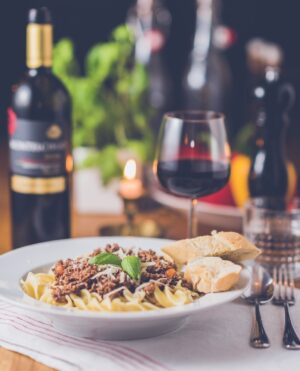Food and Wine Pairing

Food and Wine Pairing:
Wine is most enjoyed when consumed with food. It enhances the taste of the food and vice versa. South Africa has a rainbow nation and our various cuisines are equally colourful with the blending of east meets west as well as native dishes and ingredients included into our food menus.
The tongue has thousands of taste buds and areas of the tongue allow us to taste salt, sweet, bitter, sour, spicy and umami. This makes pairing food and wine both simple and sometimes complicated.
The following information is only a guideline. It is advisable to always try out your favourite wines with various food combinations to see what you like best.
When food pairing, rather pick out your favourite wine first, before trying to match a dish with it.
Guidelines:
- Acidic – acidic flavour is described as sour, and acidic foods and beverages makes your mouth salivate e.g . eating fresh lemon or limes will give you an idea of what I mean.
- Tannin – tannin in wine, specifically red wine is the level of “dryness” that you feel on your tongue; occasional you will hear very high tannin wines referred to as “bone dry. Ïf you are unfamiliar with this taste, then taste some black tea; this will give you the experience of your tongue going dry from the bitterness of that tannin.
- Dry/Sweetness – refers to the level of residual sugar in the wine. The less sugar in the wine, the more dry the wine will be e.g Rosé wine has a range of very dry to very sweet.
Food Flavours:
- Acidic:
If your food is acidic, choose a wine that is more acidic than the food.
Please take sauces and salad dressings into consideration; this is the food component that must be paired with the wine you are drinking.
- Salty:
Salty foods/snacks complement dry wines. The wine will seem fruitier and salt softens the tannins in red wines.
- Sweet:
Choose a wine that is sweeter than the dish. The sweetness in dishes e.g desserts can make a dry wine seem more acidic and less fruity.
- Fatty:
Fatty meats, creamy sauces and cheese falls in this category. Fatty foods make wines seem less acidic therefore most fatty foods can be consumed with highly acidic wines.
- Chilli (hot):
Hot spiced (chilli) food reacts with the alcohol in wine and can make the food taste more hot. Choose a low alcohol red or white wine to drink with chilli flavoured foods.
- Umami:
Umami tends to be present with other tastes in various dishes. Umami includes foods like mushrooms, miso, biltong and aged cheeses. Acidic red wines go well with grilled mushrooms. Low alcohol red wines go well with biltong. High acid wines with cheese are a good combination.
Using the above guidelines, see below list of wine varietals that have different levels of acid and tannin. Some wines may be considered dry but have a fruiter taste.
SOUTH AFRICA’S MOST COMMON VARIETIES *
*Assumption is that all wines listed above are single varietals and not blended wines. Some wines fall under two box categories e.g. Pinotage and Shiraz/Syrah.
*South Africa’s warmer climate tends to provide high alcohol wines however several cool climate regions are providing some amazing low alcohol wines and wine retailers are now proactively offering low alcohol wines as the trend continues to grow.
White Dry/High Acid (unoaked) · Sauvignon Blanc · Pinot Gris · Riesling · Chardonnay | White Dry/Medium Acid (oaked):
· Chenin Blanc · Chardonnay · Semillon · Viognier |
Red Dry/High Acid/Low Tannin (unoaked)
· Pinot Noir (fruity when young) · Grenache · Cinsaut · Pinotage (medium tannin) | Red Dry/High Acid/High Tannin (oaked)
· Cabernet Sauvignon · Shiraz/Syrah (medium to high tannin and acid) · Malbec |
Red Dry/Medium Acid/Medium Tannin:
· Merlot · Shiraz/Syrah (medium to high tannin and acid) · Pinotage (high acid) | Red Dry/Low Acid/Low to Medium Tannin: · Grenache |
Sweet (including Sherry and Port styles)
· Gewurztraminer · Cape Ruby · Cape Tawny · Old Brown · Fortified Chenin | Dry/Low Alcohol*:
· Pinot Noir (red) · Grenache red) · Cinsaut (red) · Riesling (white) |
